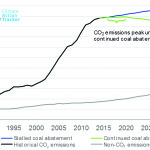In this column last month I quoted Indian Environmental Minister Jairam Ramesh to represent India’s intention to not agree to any legally binding emissions targets at the Copenhagen Climate Change Conference in December. That conference will start formal negotiations of a follow-on agreement to the Kyoto Protocol. A number of readers wrote to say that they believe India and China, despite their protestations to the contrary, will cave to international pressure and at the end of the day agree to some binding carbon emissions limits. I disagree.
It’s All About the Economy
India, in third place for annual carbon emissions, recently released multiple reports that collectively stated that the country’s carbon emissions will increase from about 1.2 billion tonnes today to between 4 billion and 7.3 billion tonnes in 2030, depending on the assumptions. The carbon emissions of China and the U.S. are estimated to be 6.8 and 6.4 million tonnes per year (depending on your source), respectively, so India is in a distant third place but is rapidly closing the gap. These three countries account for half of the world’s carbon emissions today. Both China and India have stated that it is their official policy to not commit to cuts in carbon emissions unless developed nations also promise to make significant cuts in their emissions.
Singh… said that social development is his first priority and that "the developing world cannot accept a freeze on global inequity."
Ramesh released these projections, prepared by five Indian independent institutions, during a September 2 press conference to show how serious India is about climate change. Ramesh reiterated Prime Minister Manmohan Singh’s promise that India’s per capita emissions would never exceed those of developed nations. Singh, in his January 2007 inaugural address, said that social development is his first priority and that "the developing world cannot accept a freeze on global inequity," meaning that the measures taken by the global community to deal with climate change must be evenly distributed, and keeping a billion or more of India’s citizens in poverty is unacceptable.
Ramesh described India’s carbon emission increases as "quite moderate" on an annual basis. (My calculation found an annual growth rate of 6.5% to 9% given the numbers above.) And he pledged that India’s emissions would always be lower than those of developed countries on a per capita basis: 1.2 tonnes per year today, rising to between 2.77 tonnes and 5.00 tonnes of carbon dioxide per year in 2030. By comparison, according to the U.S. Energy Information Administration, the carbon footprint of each resident in 2006 in the U.S. was 19.8 tonnes; in Germany, 10.4 tonnes; in Russia, 12 tonnes; and in Japan, 9.78 tonnes.
India Will Stand Fast
India is a developing nation with industrialized nation aspirations. In India, fertility rates remain high, at about three children per family, whereas China’s one-child policy has significantly reduced that country’s fertility rate, but with the side effect of pushing up the average age of its citizens. Also, more babies were born in India than in China each year since at least 1997. Here’s another telling statistic: Over 40% of India’s population is younger than 15 years. With 1.15 billion people today, rising over 20% in the last decade alone, India is rapidly closing the gap with China’s 1.3 billion people and will surpass China’s population around 2030. India’s projected 2030 population is 1.5 billion — a fivefold increase since 1950, compared with a projected increase of half that rate in the U.S. over the same period.
The demographic data confirm that Singh’s priority must be to grow jobs and increase opportunity by building infrastructure, including conventional power plants in great numbers, for the foreseeable future. The data also explain why two-thirds of all carbon emissions in India come from coal-fired power plants. By 2017, India will have added another 117 GW of coal-fired power plants, about half the capacity of the current U.S. fleet of coal-fired plants.
The Tight-Knit Couple
"India will easily become the second largest CO 2 emitter after China by 2020," says K. Srinivas, former policy advisor at Greenpeace. "If India has to stick to the two degrees Celsius target (requiring about a 40% reduction in carbon emissions by 2020), we will need a major tweaking of our power generation road map in favor of renewable sources," he adds. "But India refuses to let go of coal-fired power because it is the most viable option for a power-starved nation."
Srinivas is absolutely correct. The only path out of poverty for India’s citizens is an abundant and low-cost supply of electricity, and that means continuing to construct coal-fired power plants at a rapid rate for the foreseeable future. Per-capita carbon emissions will remain below those of developed countries, but the absolute quantities will continue to rise, as will those of China, for the same reason. By 2030, India and China will emit perhaps half of the world’s carbon, and the U.S. will fall back into the pack.
I believe that India and China will take firm control of Copenhagen negotiations by standing together against any substantive carbon emissions limits for developing countries. If so, the groundwork now being laid for the Copenhagen talks is likely to become quicksand come December.
–Dr. Robert Peltier, PE, Editor-in-Chief










